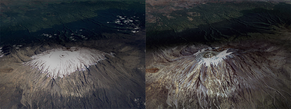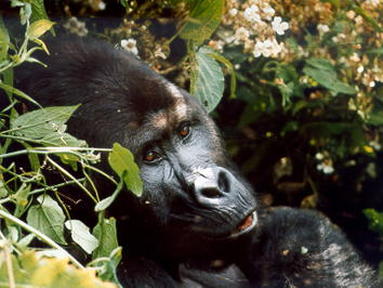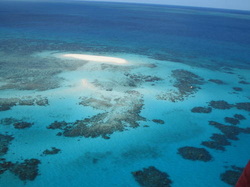
Picture showing the changes in the Kilimanjaro snowfields.
Climate change is driving the loss of the snows on Kilimanjaro. As glaciologist Lonnie Thompson from Ohio State University in Columbus points out in an article from the National Geographic News Service online, it is the melting of the glaciers from the margins and periphery, but also the thinning of the ice packs (John Roach, NG News, Nov. 2 , 2009). To quote the article:
Thompson and his colleagues have studied Kilimanjaro's dwindling ice for several decades.
The mountain, they say, has lost 85 percent of its glacial ice since 1912. What's more, 26 percent of the ice that remained in 2000 was gone by 2007, the last time Kilimanjaro's ice was precisely mapped.
They also state that up to 50% of the glaciers thickness has disappeared since 2000, and the mountain could be ice free as early as 2018.
This melting is coming from increased temperatures in the region as well as changes in the amount of precipitation also affected by temperature. There is also a study that is beginning to link weather changes to deforestation in a 2,000 mile area around the mountain (http://www.sciencedaily.com/releases/2011/03/110305112136.htm). Although not conclusive either way in the ongoing study, this is only another factor that may be teamed up with weather patterns generated off the Indian Ocean.
Thompson and his colleagues have studied Kilimanjaro's dwindling ice for several decades.
The mountain, they say, has lost 85 percent of its glacial ice since 1912. What's more, 26 percent of the ice that remained in 2000 was gone by 2007, the last time Kilimanjaro's ice was precisely mapped.
They also state that up to 50% of the glaciers thickness has disappeared since 2000, and the mountain could be ice free as early as 2018.
This melting is coming from increased temperatures in the region as well as changes in the amount of precipitation also affected by temperature. There is also a study that is beginning to link weather changes to deforestation in a 2,000 mile area around the mountain (http://www.sciencedaily.com/releases/2011/03/110305112136.htm). Although not conclusive either way in the ongoing study, this is only another factor that may be teamed up with weather patterns generated off the Indian Ocean.

The low land gorilla's habitat is threatened by illegal logging, deforestation and war.
Having pointed out some of the concerns about Mt Kili, I would also like to introduce you to another endangered African National Park. This park is Kahuzi-Biega National Park in the Democratic Republic of Congo (http://whc.unesco.org/en/list/137/) . This area of tropical rainforest that has a long list of unique flora and fauna (the most notable charismatic mega-fauna being the low land gorilla) faces many challenges. When it comes to the five successfully sustainable management principles, it fails to collaborate with the local populace with no real fit between its communities and tourism. Probably the saddest component is that it has no way to protect its natural resources. UNESCO recalls that since the parks’ inception there has been strife from villagers that were incorporated into the park as well as no delineated boundaries to protect from deforestation and oil exploration as a means to combat poverty in the region. War, political instability and its refugees have fled into the forests as they were displaced have also affected the parks with resource use and degradation. Enforcement is also minimal as the parks are described as “under-staffed”.

The Great Barrier Reef
It is probably not a fair comparison, but a completely different biome can be managed in a much more successful manner. As a huge underwater ecosystem (able to be seen from space) The Great Barrier Reef off of the coast of Australia has different protections in that it can be treated somewhat like an island by the protecting government http://whc.unesco.org/en/list/154. Although, it is not truly isolated like an island might be, it is actually guarded by many overlapping jurisdictions. It has the local government of Queensland, as well as being a Federal Marine Park overseeing and cooperating in its use and study. This is collaboration to protect its resources also helps manage it as a learning and research area as well as recreational multi-use resource. Besides boating and diving, overseeing agencies also set guidelines for travel, shipping, fishing/harvesting and sea dumping. They also engage the indigenous cultures with Traditional Use of Marine Resource Agreements (TUMRAs) and Indigenous Land Use Agreements (ILUAs) to support Traditional Owners to maintain cultural connections with their sea country. Although the reef is actually soaking in the ocean and all the environmental changes that can be passed through it (pollution, rising sea temperatures and invasive species blooms), it is the strong and multilayered cooperative that protects this biome and ensures its enjoyment by all.
 RSS Feed
RSS Feed